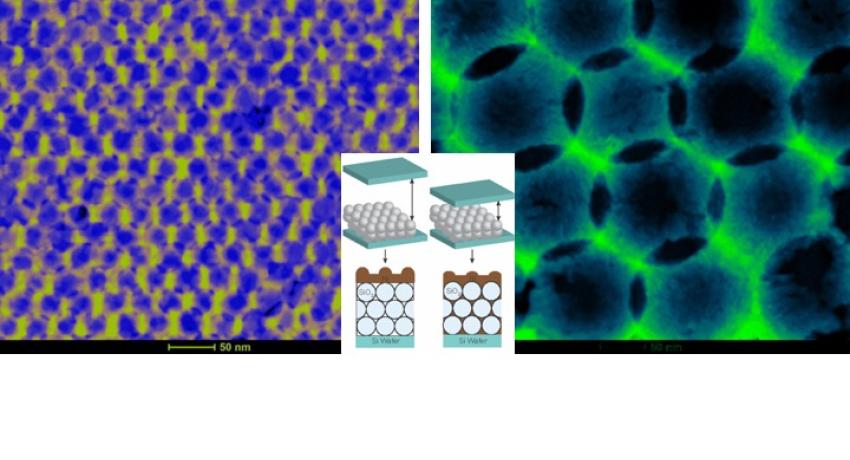Contributed by: Penn State MRSEC DMR-1420620. Yunzhi Liu, Susan Kempinger, Rongrui He, Todd Day, Parivash Moradifar, Shih-Ying Yu, Jennifer Russell, Vincent Torres, Pengtao Xu, Thomas Mallouk, Suzanne Mohney, Nasim Alem, Nitin Samarth, John Badding
Image Caption:
Magnetic metalattices are highly structured on a small scale of nanometers with many voids and interconnections. On this very small scale, the lines of magnetization within the ferromagnet are resistant to bending to follow the contours of the convoluted interior surfaces, yet they also prefer not to terminate on the interior surfaces, since that would increase the magnetostatic energy. Faced with these competing requirements, modeling predicts that nature finds interesting compromises. In particular, the magnetization pattern can jump abruptly between various topologically distinct states: spirals, hedgehogs, streams, etc. as a function of the external magnetic field applied. Unlike the transient patterns that appear during a field reversal in a regular bulk magnet, these topologically distinct states are stable and persistent. Using high pressure confined chemical vapor deposition we have infiltrated the voids between nanoscale (14 nm to 100 nm diameter) silica spheres with nickel to form nickel metalattices. The resulting structures are nearly void free and highly interconnected, unlike isolated nickel metal nanoparticles. Whereas nickel nanoparticles behave as independent superparamagnets, nickel metalattices behave magnetically as truly interconnected yet nanoscale systems. Direct exchange between the nickel “meta-atoms” of the metalattices mediated by “meta-bonds” thus seems likely.
We synthesized nanoporous magnetic metalattices by high pressure confined chemical vapor deposition of nickel into silica sphere nanotemplates. Modeling predicts that competition between confinement and the resistance to bending of the magnetic lines of force in these structures should stabilize a series of topologically distinct magnetic states, such as hedgehogs, streams, and spirals. We confirmed that the metalattices behave as truly interconnected, yet confined systems. Such new examples of magnetic materials have often proved useful in applications ranging from data storage to biomedical technologies.
Nanoletters 2018, 18,1, 546-552.
DOI: https://doi.org/10.1021/acs.nanolett.7b04633
Credits/Names: Penn State MRSEC DMR-1420620. Yunzhi Liu, Susan Kempinger, Rongrui He, Todd Day, Parivash Moradifar, Shih-Ying Yu, Jennifer Russell, Vincent Torres, Pengtao Xu, Thomas Mallouk, Suzanne Mohney, Nasim Alem, Nitin Samarth, John Badding
Download PDF Version: IRG3 Magnetic Metalattices.pdf
Year of Highlight: 2019
IRG: IRG3 - Metalattices


